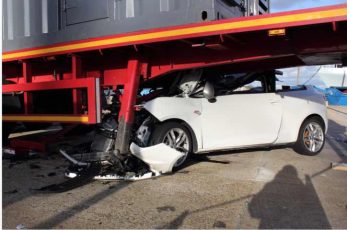
Each year, more than 200 deaths are linked to underride crashes. Many of these fatalities could have been prevented if large commercial trucks were required to be equipped with side and front underride protection.
Deadly Underride Crashes
When large trucks are not equipped with side and front underride protection and they collide with smaller vehicles, passenger cars can slide partially or completely underneath the trailer. Underride collisions are some of the most deadly types of crashes, accounting for approximately 25% of fatalities from truck-involved accidents.
A crash with a large commercial truck, especially at high speed, is always dangerous because of the truck’s size and weight. Large semi-trucks that travel on highways and interstates can weigh as much as 80,000 pounds when fully loaded with cargo. When truck underride crashes happen, passenger car occupants are often crushed or severely injured upon impact. In many cases, the car’s roof is actually sheered off. Since the car slides under the truck, the car’s front bumper does not absorb the crash impact, so airbags and seatbelts provide little protection. In Nevada underride crashes, Reno truck crash lawyers have seen a high rate of fatalities.
Rear Underride Collisions
Rear underride collisions occur when a passenger vehicle runs under the rear end of a truck or semi-trailer. These accidents are often caused by speeding, tailgating, poorly marked trailers, dim or faulty taillights and/or flashers, and sudden stops. On highways and interstates, cars traveling at speeds of 55 to 75 mph may not expect to approach large trucks traveling at slower speeds. When traveling at night, difficulty in judging distance often contributes to a fatal underride crash.
Side Underride Collisions
Side underride collisions often occur when a truck driver is backing across traffic, attempting a U-turn, or turning onto a street or highway. Many vehicle drivers do not see trucks crossing their path until it’s too late to stop. If the side of the truck or trailer is not marked with lights or reflective tape, a side underride collision can easily occur, especially at night or on roads with minimal traffic.
Rear guards have been mandatory on trailers since 1953. In 2017, The Stop Underrides Act of 2017 proposed legislation requiring side and front underride guards on commercial trucks and trailers, but these safety measures are currently still optional due to a push back from the trucking industry.









